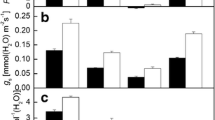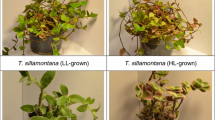Abstract
Haberlea rhodopensis belongs to the group of homoiochlorophyllous desiccation-tolerant plants which preserve their chlorophyll content during dehydration. It is a typical shade adapted plant and it is proved to be very sensitive to light intensity higher than the natural during drought stress. To reveal the reasons of their light sensitivity, we compared the damages and protective mechanisms of shade plants during desiccation either simulating their natural light conditions (30 μmol photons m−2 s−1, LL) or at a moderately higher light intensity (100 μmol photons m−2 s−1, ML). In the desiccated stage, no damage could be discovered in terms of thylakoid membrane quantity or integrity either at LL or ML. Nevertheless, the altered structure and localization of chloroplasts did not restore in plants desiccated and rehydrated at ML, where no starch could be re-synthesized, but a number of plastoglobuli appeared. The PSII activity and the amount of β-carotene and lutein decreased more strongly in ML leaves in agreement with their higher MDA production. Lack of recovery of ML plants may be connected with the very high number of damaged PSII reaction centres caused by the loss of the subtle balance between ROS production and scavenging. In addition, because of the impaired starch re-synthesis, there is no sink for the water-replacing sugars and water cannot be taken up which proved to be lethal to ML plants.





Similar content being viewed by others
References
Apostolova E, Rashkova M, Anachkov N, Denev I, Toneva V, Minkov I, Yahubyan G (2012) Molecular cloning and characterization of cDNAs of the superoxide dismutase gene family in the resurrection plant Haberlea rhodopensis. Plant Physiol Biochem 55:85–92
Asada K (1999) The water-water cycle in chloroplasts: scavenging of active oxygen and dissipation of excess photons. Annu Rev Plant Physiol Plant Mol Biol 50:601–639
Augusti A, Scartazza A, Navari-Izzo F, Sgherri CLM, Stevanovic B, Brugnoli E (2001) Photosystem II photochemical efficiency, zeaxanthin and antioxidant contents in the poikilohydric Ramonda serbica during dehydration and rehydration. Photosynth Res 67:79–88
Belkhodja R, Morales F, Quílez R, López-Millán AF, Abadía A, Abadía J (1998) Iron deficiency causes changes in chlorophyll fluorescence due to the reduction in the dark of the photosystem II acceptor side. Photosynth Res 56:265–276
Caffarri S, Croce R, Breton J, Bassi R (2001) The major antenna complex of photosystem II has a xanthophyll binding site not involved in light harvesting. J Biol Chem 276:35924–35933
Casper C, Eickmeier WG, Osmond CB (1993) Changes of fluorescence and xanthophyll pigments during dehydration in the resurrection plant Selaginella lepidophylla in low and medium light intensities. Oecologia 94:528–533
Chow WS, Lee HY, Park YI, Park YM, Hong YN, Anderson JM (2002) The role of inactive photosystem-II-mediated quenching in a last-ditch community defence against high light stress in vivo. Philos Trans R Soc Lond 357B:1441–1450
Dall’Osto L, Cazzaniga S, North H, Marion-Poll M, Bassi R (2007) The Arabidopsis aba4-1 mutant reveals a specific function for neoxanthin in protection against photooxidative stress. Plant Cell 19:1048–1064
Dall’Osto L, Cazzaniga S, Havaux M, Bassi R (2010) Enhanced photoprotection by protein-bound versus free xanthophyll pools. A comparative analysis of chlorophyll b and xanthophyll biosynthesis mutants. Mol Plant 3:576–593
Dall’Osto L, Holt NE, Shanti Kaligotla S, Fuciman M, Cazzaniga S, Carbonera D, Frank HA, Alric J, Bassi R (2012) Zeaxanthin protects plant photosynthesis by modulating chlorophyll triplet yield in specific light-harvesting antenna subunits. J Biol Chem 287:41820–41834
Das K, Roychoudhury A (2014) Reactive oxygen species (ROS) and response of antioxidants as ROS-scavengers during environmental stress in plants. Front Environ Sci 2:article 53
Daskalova E, Dontcheva S, Yahoubian G, Minkov I, Toneva V (2011) A strategy for conservation and investigation of the protected resurrection plant Haberlea rhodopensis Friv. BioRisk 6:41–60
Dinakar C, Bartels D (2012) Light response, oxidative stress management and nucleic acid stability in closely related Linderniaceae species differing in desiccation tolerance. Planta 236:541–555
Dinakar C, Djilianov D, Bartels D (2012) Photosynthesis in desiccation tolerant plants: energy metabolism and antioxidative stress defense. Plant Sci 182:29–41
Djilianov D, Ivanov S, Moyankova D, Miteva L, Kirova E, Alexieva V, Joudi M, Peshev D, Van den Ende W (2011) Sugar ratios, glutathione redox status and phenols in the resurrection species Haberlea rhodopensis and the closely related non-resurrection species Chirita eberhardtii. Plant Biol 13:767–776
Douce R, Holtz RB, Benson AA (1973) Isolation and properties of envelope of spinach-chloroplasts. J Biol Chem 248:7215–7222
Farrant JM (2000) Comparison of mechanisms of desiccation tolerance among three angiosperm resurrection plants. Plant Ecol 151:29–39
Farrant JM, Vander Willigen C, Loffell DA, Bartsch S, Whittaker A (2003) An investigation into the role of light during desiccation of three angiosperm resurrection plants. Plant Cell Environ 26:1275–1286
Foyer C, Noctor G (2000) Oxygen processing in photosynthesis: regulation and signaling. New Phytol 146:359–388
García-Plazaola JI, Esteban R, Fernández-Marín B, Kranner I, Porcar-Castell A (2012) Thermal energy dissipation and xanthophyll cycles beyond the Arabidopsis model. Photosynth Res 113:89–103
Gechev TS, Benina M, Obata T, Tohge T, Sujeeth N, Minkov I, Hille J, Temanni M-R, Marriott AS, Bergström E, Thomas-Oates J, Antonio C, Mueller-Roeber B, Schippers JHM, Fernie AR, Toneva V (2013) Molecular mechanisms of desiccation tolerance in the resurrection glacial relic Haberlea rhodopensis. Cell Mol Life Sci 70:689–709
Georgieva K, Szigeti Z, Sárvári É, Gáspár L, Maslenkova L, Peeva V, Peli E, Tuba Z (2007) Photosynthetic activity of homoiochlorophyllous desiccation tolerant plant Haberlea rhodopensis during dehydration and rehydration. Planta 225:955–964
Georgieva K, Lenk S, Buschmann C (2008) Responses of the resurrection plant Haberlea rhodopensis to high irradiance. Photosynthetica 46:208–215
Georgieva K, Sárvári É, Keresztes Á (2010) Protection of thylakoids against combined light and drought by a lumenal substance in the resurrection plant Haberlea rhodopensis. Ann Bot 105:117–126
Georgieva K, Rapparini F, Bertazza G, Mihailova G, Sárvári É, Solti Á, Keresztes Á (2015) Alterations in the sugar metabolism and in the vacuolar system of mesophyll cells contribute to the desiccation tolerance of Haberlea rhodopensis ecotypes. DOI. doi:10.1007/s00709-015-0932-0
Gilmore AM, Shinkarev VP, Hazlett TL, Govindjee (1998) Quantitative analysis of the effects of intrathylakoid pH and xanthophyll cycle pigments on chlorophyll a fluorescence lifetime distributions and intensity in thylakoids. Biochemistry 37:13582–13593
Goodwin TW, Britton G (1988) Distribution and analysis of carotenoids. In: Goodwin TW (ed) Plant Pigments. Academic Press, London, pp 62–132
Havaux M, Dall’Osto L, Cuiné S, Giuliano G, Bassi R (2004) The effect of zeaxanthin as the only xanthophyll on the structure and function of the photosynthetic apparatus in Arabidopsis thaliana. J Biol Chem 279:13878–13888
Havaux M, Dall’osto L, Bassi R (2007) Zeaxanthin has enhanced antioxidant capacity with respect to all other xanthophylls in Arabidopsis leaves and functions independent of binding to PSII antennae. Plant Physiol 145:1506–1520
Heath R, Packer L (1968) Photoperoxidation in isolated chloroplasts. I. Kinetics and stoichiometry of fatty acid peroxidation. Arch Biochem Biophys 125:189–198
Heber U, Bukhov NG, Shuvalov VA, Kobayashi Y, Lange OL (2001) Protection of the photosynthetic apparatus against damage by excessive illumination in homoiohydric leaves and poikilohydric mosses and lichens. J Exp Bot 52:1999–2006
Heber U, Bilger W, Shuvalov V (2006) Thermal energy dissipation in reaction centres and in the antenna of photosystem II protects desiccated poikilohydric mosses against photo-oxidation. J Exp Bot 57:2993–3006
Hendrickson L, Förster B, Pogson BJ, Chow WS (2005) A simple chlorophyll fluorescence parameter that correlates with the rate coefficient of photoinactivation of Photosystem II. Photosynth Res 84:43–49
Horton P, Wentworth M, Ruban A (2005) Control of the light harvesting function of chloroplast membranes: the LHCII aggregation model for non-photochemical quenching. FEBS Lett 579:4201–4206
Lawlor DW, Cornic G (2002) Photosynthetic carbon assimilation and associated metabolism in relation to water deficits in higher plants. Plant Cell Environ 25:275–294
Mihailova G, Petkova S, Büchel C, Georgieva K (2011) Desiccation of the resurrection plant Haberlea rhodopensis at high temperature. Photosynth Res 108:5–13
Moore JP, Le NT, Brandt WF, Driouich A, Farrant JM (2009) Towards a systems-based understanding of plant desiccation tolerance. Trends Plant Sci 14:110–117
Mozzo M, DallOsto L, Hienerwadel R, Bassi R, Croce R (2008) Photoprotection in the antenna complexes of photosystem II. Role of individual xanthophylls in chlorophyll triplet quenching. J Biol Chem 283:6184–6192
Neill SO, Gould KS, Kilmartin PA, Mitchell KA, Markham KR (2002) Antioxidant activities of red versus green leaves in Elatostema rugosum. Plant Cell Environ 25:539–547
Peguero-Pina JJ, Gil-Pelegrín E, Morales F (2013) Three pools of zeaxanthin in Quercus coccifera leaves during light transitions with different roles in rapidly reversible photoprotective energy dissipation and photoprotection. J Exp Bot 64:1649–1661
Piller LE, Glauser G, Kessler F, Besagni C (2014) Role of plastoglobules in metabolite repair in the tocopherol redox cycle. Front Plant Sci 5:298
Ramanjulu S, Bartels D (2002) Drought- and desiccation-induced modulation of gene expression in plants. Plant Cell Environ 25:141–151
Rapparini F, Neri L, Mihailova G, Petkova S, Georgieva K (2015) Growth irradiance affects the photoprotective mechanisms of the resurrection angiosperm Haberlea rhodopensis Friv. in response to desiccation and rehydration at morphological, physiological and biochemical levels. Environ Exp Bot 113:67–79
Sárvári É, Mihailova G, Solti Á, Keresztes Á, Velitchkova M, Georgieva K (2014) Comparison of thylakoid structure and organization in sun and shade Haberlea rhodopensis populations under desiccation and rehydration. J Plant Physiol 171:1591–1600
Sherwin H, Farrant J (1998) Protection mechanisms against excess light in the resurrection plants Craterostigma wilmsii and Xerophyta viscose. Plant Growth Regul 24:203–210
Solti Á, Lenk S, Mihailova G, Mayer P, Barócsi A, Georgieva K (2014) Effects of habitat light conditions on the excitation quenching pathways in desiccating Haberlea rhodopensis leaves: an Intelligent FluoroSensor study. J Photochem Photobiol B 130:217–225
Solti Á, Sárvári É, Szöllősi E, Tóth B, Mészáros I, Fodor F, Szigeti Z (2016a) Stress hardening under long-term cadmium treatment is correlated with the activation of antioxidative defence and iron acquisition of chloroplasts in Populus. Z Naturforsch C 71:323–334
Solti Á, Sárvári É, Tóth B, Mészáros I, Fodor F (2016b) Incorporation of iron into chloroplasts triggers the restoration of cadmium induced inhibition of photosynthesis. J Plant Physiol 202:97–106
Strasser RJ, Tsimilli-Michael M, Qiang S, Goltsev V (2010) Simultaneous in vivo recording of prompt and delayed fluorescence and 820-nm reflection changes during drying and after rehydration of the resurrection plant Haberlea rhodopensis. Biochim Biophys Acta 1797:1313–1326
Sun Z-L, Lee H-L, Matsubara S, Hope AB, Pogson BJ, Hong Y-N, Chow WS (2006) Photoprotection of residual functional photosystem II units that survive illumination in the absence of repair, and their critical role in subsequent recovery. Physiol Plant 128:415–424
Toldi O, Tuba Z, Scott P (2009) Vegetative desiccation tolerance: is it a goldmine for bioengineering crops? Plant Sci 176:187–199
Tóth VR, Mészáros I, Sz Veres, Nagy J (2002) Effects of the available nitrogen on the photosynthetic activity and xanthophyll cycle pool of maize in field. J Plant Physiol 159:627–634
Tuba Z, Proctor MCF, Csintalan Z (1998) Ecophysiological responses of homoiochlorophyllous and poikilochlorophyllous desiccation-tolerant plants: a comparison and an ecological perspective. Plant Growth Regul 24:211–217
Vidi P-A, Kanwischer M, Baginsky S, Austin JR, Csucs G, Dörmann P, Kessler F, Bréhélin C (2006) Tocopherol cyclase (VTE1) localization and vitamin E accumulation in chloroplast plastoglobule lipoprotein particles. J Biol Chem 281:11225–11234
Yahubyan G, Gozmanova M, Denev I, Toneva V, Minkov I (2009) Prompt response of superoxide dismutase and peroxidase to dehydration and rehydration of the resurrection plant Haberlea rhodopensis. Plant Growth Regul 57:49–56
Acknowledgements
Á. Solti, É. Sárvári, Á. Keresztes, and K. Georgieva kindly acknowledge the travel exchange agreement of the Bulgarian and Hungarian Academy of Sciences. Á. Solti was also supported by the Bolyai János Research Scholarship of the Hungarian Academy of Sciences (BO/00207/15/4).
Author information
Authors and Affiliations
Corresponding author
Additional information
Communicated by K. Apostol.
Electronic supplementary material
Below is the link to the electronic supplementary material.
Rights and permissions
About this article
Cite this article
Georgieva, K., Solti, Á., Mészáros, I. et al. Light sensitivity of Haberlea rhodopensis shade adapted phenotype under drought stress. Acta Physiol Plant 39, 164 (2017). https://doi.org/10.1007/s11738-017-2457-y
Received:
Revised:
Accepted:
Published:
DOI: https://doi.org/10.1007/s11738-017-2457-y




